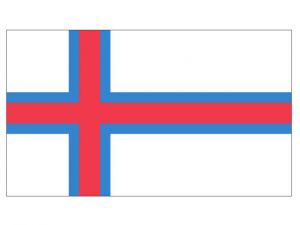Language/Faroese/Vocabulary/Numbers-1-20
| ◀️ Verb To Be — Previous Lesson | Next Lesson — Telling Time ▶️ |
Introduction[edit | edit source]
In this lesson, we will dive into the world of numbers in the Faroese language. Numbers are an essential part of everyday life, and learning how to count in Faroese will enable you to communicate effectively in various situations. Whether you are shopping, telling time, or simply counting objects, having a strong foundation in numbers is crucial. By the end of this lesson, you will be able to confidently count from 1 to 20 in Faroese and understand the pronunciation of each number. So, let's get started!
Numbers 1-10[edit | edit source]
Let's begin by learning the numbers from 1 to 10 in Faroese. Take a look at the table below to familiarize yourself with the Faroese numbers and their pronunciations:
| Faroese | Pronunciation | English Translation |
|---|---|---|
| ein | [aɪn] | one |
| tvey | [tveɪ] | two |
| trý | [trʊɪ] | three |
| fýra | [fyːra] | four |
| fimm | [fɪm] | five |
| seks | [sɛks] | six |
| sjey | [ʃɛɪ] | seven |
| átta | [ɔʊ̯ta] | eight |
| níggju | [nɪdʒʊ] | nine |
| tíggju | [tʰʊɪdʒʊ] | ten |
Take your time to practice pronouncing each number correctly. Pay attention to the stress and vowel sounds in each word. Repeat after the audio recordings to improve your pronunciation.
Numbers 11-20[edit | edit source]
Now, let's move on to the numbers from 11 to 20 in Faroese. These numbers follow a specific pattern, which makes them relatively easy to learn. Take a look at the table below:
| Faroese | Pronunciation | English Translation |
|---|---|---|
| ellivu | [ˈɛlɪvʊ] | eleven |
| tólv | [tʰɔlv] | twelve |
| trettan | [trɛtan] | thirteen |
| fjórtan | [fjɔrtan] | fourteen |
| fimtan | [ˈfɪmtan] | fifteen |
| sekstan | [ˈsɛkstan] | sixteen |
| sjeytjan | [ˈʃɛɪtjan] | seventeen |
| átján | [ˈɔʊ̯tjan] | eighteen |
| nítjan | [ˈnitjan] | nineteen |
| tjúgu | [ˈtʰʊɪkʊ] | twenty |
Again, take your time to practice pronouncing each number correctly. Note that the numbers 11-19 are formed by combining the word for "ten" (tíggju) with the respective unit digit. For example, "eleven" is "tíggju og ein," and "fifteen" is "tíggju og fimm." This pattern continues until we reach twenty (tjúgu).
Cultural Insight[edit | edit source]
Numbers play an important role in Faroese culture, particularly in traditional folklore and superstitions. For example, the number 13 is considered unlucky in many cultures, and Faroese folklore is no exception. In Faroese folklore, it is believed that the number 13 attracts misfortune and should be avoided whenever possible. This superstition is so strong that some buildings in the Faroe Islands skip the 13th floor or label it as something else, such as the 12A or 14th floor. It's interesting to note how cultural beliefs and traditions can shape our perception of numbers.
Practice Exercises[edit | edit source]
Now it's time to put your knowledge of numbers into practice! Below are a few exercises to help you reinforce what you've learned:
Exercise 1: Write the Numbers Write the Faroese numbers corresponding to the English translations given below:
- Eight
- Fourteen
- Six
- Twenty
- Eleven
Exercise 2: Fill in the Blanks Fill in the blanks with the correct Faroese numbers:
- Tíggju og ____ = Twelve
- Sjey og ____ = Seventeen
- Fýra og ____ = Fourteen
- ____ og níggju = Twenty-nine
- ____ og fimm = Fifteen
Exercise 3: Listening Comprehension Listen to the audio recording and write down the numbers you hear. Then, check your answers. (Audio recording: [audio link])
Solutions[edit | edit source]
Exercise 1:
- Átta
- Fjórtan
- Seks
- Tjúgu
- Ellivu
Exercise 2:
- Tólv
- Sjeytjan
- Fjórtan
- Níggju og tíggju
- Fimm
Exercise 3:
- [Transcribe the numbers from the audio recording here]
Conclusion[edit | edit source]
Congratulations! You have successfully learned the numbers from 1 to 20 in Faroese. You can now count and understand basic numerical information in Faroese. Keep practicing your pronunciation and reinforce your knowledge by using numbers in real-life situations. In the next lesson, we will explore how to tell time in Faroese, so stay tuned!
Videos[edit | edit source]
Faroese numbers - YouTube[edit | edit source]
Sources[edit | edit source]
Other Lessons[edit | edit source]
- Introducing Yourself
- Clothes
- Drinks
- Colors
- Food
- Common Foods
- Feelings and Emotions
- Days of the Week
- Modes of Transportation
- Education
| ◀️ Verb To Be — Previous Lesson | Next Lesson — Telling Time ▶️ |

